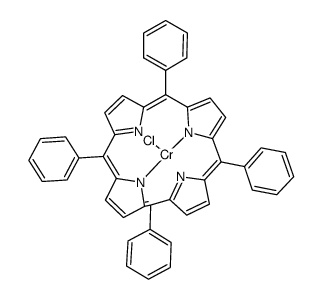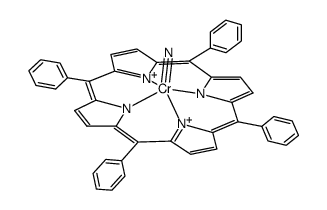Chromium (III) tetraphenylporphine chloride
Modify Date: 2025-10-29 16:28:39

Chromium (III) tetraphenylporphine chloride structure
|
Common Name | Chromium (III) tetraphenylporphine chloride | ||
|---|---|---|---|---|
| CAS Number | 28110-70-5 | Molecular Weight | 700.16900 | |
| Density | N/A | Boiling Point | N/A | |
| Molecular Formula | C44H28ClCrN4 | Melting Point | N/A | |
| MSDS | N/A | Flash Point | N/A | |
| Name | Chromium (III) tetraphenylporphine chloride |
|---|---|
| Synonym | More Synonyms |
| Molecular Formula | C44H28ClCrN4 |
|---|---|
| Molecular Weight | 700.16900 |
| Exact Mass | 699.14100 |
| PSA | 34.58000 |
| LogP | 7.12730 |
| InChIKey | DJXCXCGPVDGHEU-UHFFFAOYSA-M |
| SMILES | C1=Cc2nc1c(-c1ccccc1)c1ccc([n-]1)c(-c1ccccc1)c1nc(c(-c3ccccc3)c3ccc([n-]3)c2-c2ccccc2)C=C1.[Cl-].[Cr+3] |
|
Section 1: Product Identification Chemical Name:Chromium (III) tetraphenylporphine chloride CAS Registry Number:28110-70-5 Formula:(C44H28N4)CrCl EINECS Number:none Chemical Family:metal porphine (porphyrin) complex Synonym:none
Section 2: Composition and Information on Ingredients IngredientCAS NumberPercentACGIH (TWA)OSHA (PEL) Title compound28110-70-5100%0.5mg/m3 (as Cr)0.5mg/m3 (as Cr) Section 3: Hazards Identification May be irritating to skin, eyes and respiratory tract. Limited evidence of a carcinogenic effect. Possible risk of Emergency Overview: irreversible effects. Primary Routes of Exposure:Ingestion, inhalation, eyes. Eye Contact:May cause slight or mild irritation of the eyes. Skin Contact:May cause slight to mild irritation of the skin. Inhalation:Dust may be irritating to the nose mucous membranes and respiratory tract. Ingestion:No specific information is available on the physiological effects of ingestion. Acute Health Affects:May be irritating to skin, eyes and respiratory tract. Do not breath dust. Chronic Health Affects:No particular information on the effects of long-term exposure. NTP:Yes IARC:Yes OSHA:No SECTION 4: First Aid Measures Immediately flush the eyes with copious amounts of water for at least 10-15 minutes. A victim may need Eye Exposure: assistance in keeping their eye lids open. Get immediate medical attention. Wash the affected area with water. Remove contaminated clothes if necessary. Seek medical assistance if Skin Exposure: irritation persists. Remove the victim to fresh air. Closely monitor the victim for signs of respiratory problems, such as difficulty in Inhalation: breathing, coughing, wheezing or pain. In such cases seek immediate medical assistance. Seek medical attention immediately. Keep the victim calm. Give the victim water (only if conscious). Induce Ingestion: vomiting only if directed by medical personnel. SECTION 5: Fire Fighting Measures Flash Point:no data Autoignition Temperature:no data Explosion Limits:no data Extinguishing Medium:carbon dioxide, dry powder or foam. If involved in a fire, fire fighters should be equipped with NIOSH approved positive pressure self-contained Special Fire Fighting Procedures: breathing apparatus and full protective clothing. Hazardous Combustion andIf involved in a fire this material may release toxic organic fumes. Decomposion Products: Unusual Fire or Explosion Hazards: No unusual fire or explosion hazards. SECTION 6: Accidental Release Measures Small spills can be mixed with vermiculite, sodium carbonate or other suitable non combustible adsorbent and Spill and Leak Procedures: swept up. SECTION 7: Handling and Storage Handling and Storage:Store the material in a tightly sealed container. Keep away from heat and moisture. SECTION 8: Exposure Controls and Personal Protection Eye Protection:Always wear approved safety glasses when handling a chemical substance in the laboratory. Skin Protection:Wear protective clothing and gloves. Ventilation:Material may form a fine dust. If possible, handle the material in an efficient fume hood. If ventilation is not available a respirator should be worn. The use of respirators requires a Respiratory Respirator: Protection Program to be in compliance with 29 CFR 1910.134. Ventilation:Material may form a fine dust. If possible, handle the material in an efficient fume hood. Additional Protection:No additional protection required. SECTION 9: Physical and Chemical Properties Color and Form:purple powder Molecular Weight:700.18 Melting Point:no data Boiling Point:no data Vapor Pressure:no data Specific Gravity:no data Odor:not determined Solubility in Water:soluble SECTION 10: Stability and Reactivity Stability:air and moisture stable Hazardous Polymerization:No hazardous polymerization. Conditions to Avoid:none Incompatibility:oxidizing agents Decomposition Products:carbon monoxide, carbon dioxide, nitrogen oxides, organic fumes and chromium oxide. SECTION 11: Toxicological Information RTECS Data:No information available in the RTECS files. Carcinogenic Effects:no data Mutagenic Effects:no data Tetratogenic Effects:no data SECTION 12: Ecological Information Ecological Information:No information available SECTION 13: Disposal Considerations Disposal:Dispose of according to local, state and federal regulations. SECTION 14: Transportation Shipping Name (CFR):Non-hazardous Hazard Class (CFR):NA Additional Hazard Class (CFR):NA Packaging Group (CFR):NA UN ID Number (CFR):NA Shipping Name (IATA):Non-hazardous Hazard Class (IATA):NA Additional Hazard Class (IATA):NA Packaging Group (IATA):NA UN ID Number (IATA):NA SECTION 15: Regulatory Information TSCA:Not listed in the TSCA inventory SARA (Title 313):Title compound: See category code N090 for reporting. Second Ingredient:none SECTION 16 - ADDITIONAL INFORMATION N/A |
| Precursor 0 | |
|---|---|
| DownStream 2 | |
| Boc-t-leucine |
| 5,10,15,20-tetraphenylporphyrin chromium chloride |
| 2-tert-Butoxycarbonylamino-3,3-dimethyl-butyric acid |
| MFCD00269817 |
| Boc-tert-leucine |
| N-Boc-tert-leucine |
 CAS#:28265-17-0
CAS#:28265-17-0 CAS#:84174-79-8
CAS#:84174-79-8